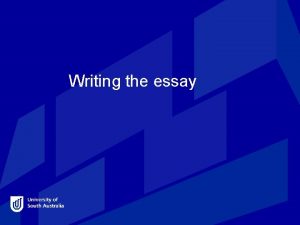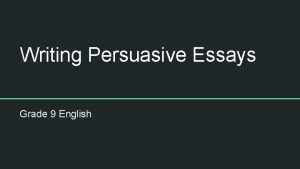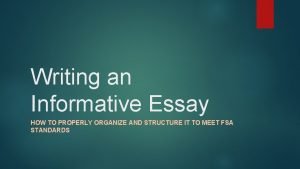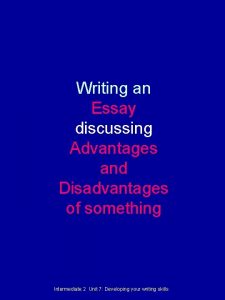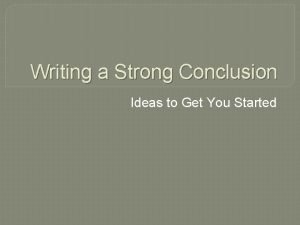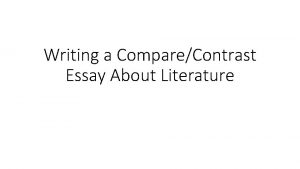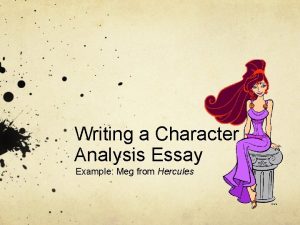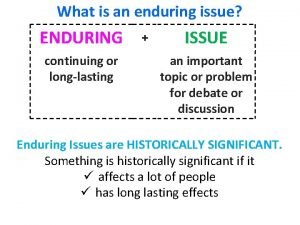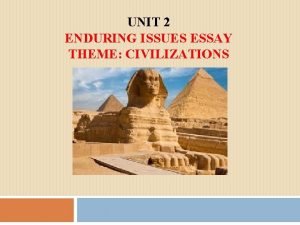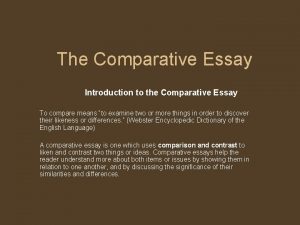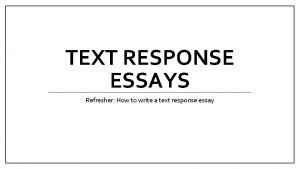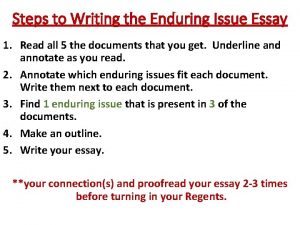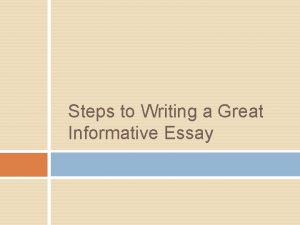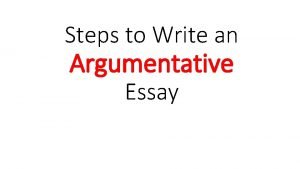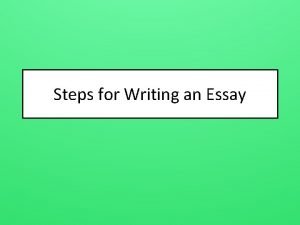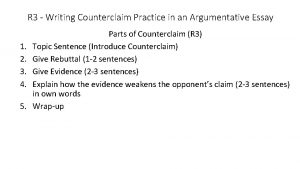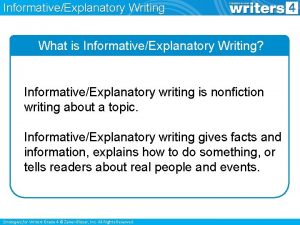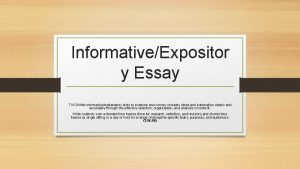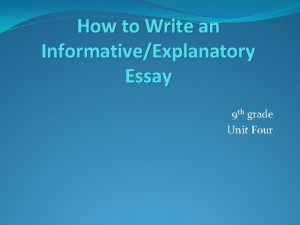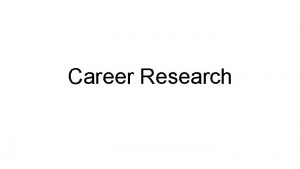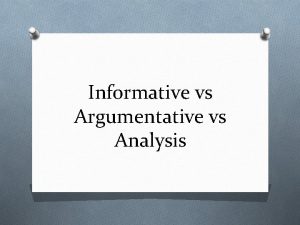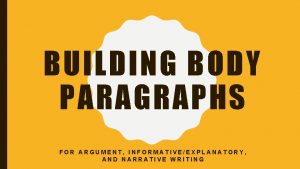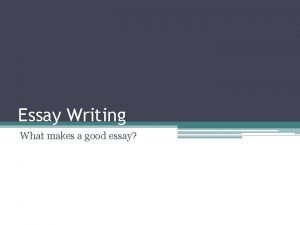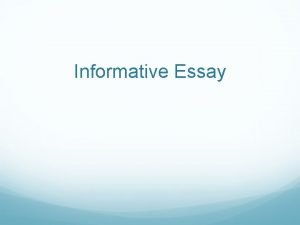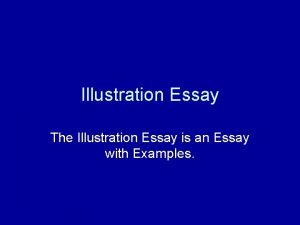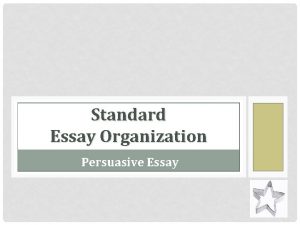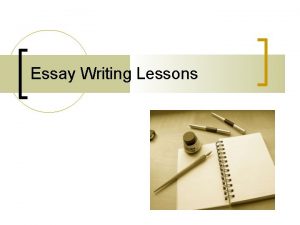InformativeExpositor y Essay 7 W 2 Write informativeexplanatory



















- Slides: 19

Informative/Expositor y Essay 7. W. 2 Write informative/explanatory texts to examine and convey complex ideas and information clearly and accurately through the effective selection, organization, and analysis of content. Write routinely over extended time frames (time for research, reflection, and revision) and shorter time frames (a single sitting or a day or two) for a range of discipline-specific tasks, purposes, and audiences. (7. W. 10)

• Do you know the difference between an expository essay and an argumentative essay?

Today we will • Take notes to identify the important elements of an expository/informative essay. • It is important to know the difference between an argumentative essay and an expository 7. W. 2 Write informative/explanatory texts to examine and convey complex ideas and information clearly essay and accurately through the effective selection, organization, and analysis of content. (7. W. 10) Write routinely over extended time frames (time for research, reflection, and revision) and shorter time frames (a single sitting or a day or two) for a range of discipline-specific tasks, purposes, and audiences.

What is an expository essay? The expository essay is a genre of essay that requires you to • investigate an idea, • evaluate evidence, • expand on the idea, and set forth information concerning that idea in a clear and concise manner.

Key Components • Expository Writing defines and explains • Introductory or lead paragraph invites the reader to explore the topic • Thesis statement reveals overall purpose of the writing • Body consists of three or more points, descriptions, or examples • Concluding paragraph restates thesis and offers the reader the opportunity to reflect further on the topic

Topic Sentence • Every paragraph should have a. topic sentence, which tells the main idea • A topic sentence (usually at the beginning of a paragraph) tells the reader what to expect.

Thesis • A clear, concise, and defined thesis statement that occurs in the first paragraph of the essay. • Should be appropriately narrowed by the guide lines set forth in the assignment • Your thesis statement should be specific—it should cover only what you will discuss in your paper and should be supported with specific evidence.

Transitions • Clear and logical transitions between the introduction, body, and conclusion • Transitions are the mortar that holds the foundation of the essay together. Without logical progression of thought, the reader is unable to follow the essay’s intent, and the structure will collapse.

Evidential Support • (expert quote) factual, logical, statistical, or anecdotal • Gives substance, authority and legitimacy to the writers point of view initially previewed in Thesis

Analysis in Body Paragraphs • Should be limited to the exposition of evidential support and how it relates to specific point • This will allow for clarity and direction throughout the essay. What is more, such conciseness creates an ease of readability for one’s audience. • It is important to note that the analysis each paragraph in the body of the essay must have some logical connection to thesis statement in the opening paragraph.

A conclusion that does not simply restate thesis • Reflects on thesis in light of the evidence provided. • This is the portion of the essay that will leave the most immediate impression on the mind of the reader. Therefore, it must be effective and logical. • DO NOT INTRODUCE ANY NEW INFORMATION INTO THE CONCLUSION; rather, synthesize and come to a conclusion concerning the information presented in the body of the essay.

Techniques • Pick evidence that clearly and directly proves your point • Paraphrase relevant facts or stories (Shorten quotes and stories) • Organization varies: chronological, order of importance, or order of familiarity • Address separate aspects of the topic in each paragraph –don’t intermix points • Paragraphs elaborate on key components –NO RHETORICAL QUESTIONS –stay with thesis • Specific details and examples support the main idea of each paragraph • Proofread and delete unrelated or unnecessary information

DO and DO NOT • DO stay in thesis order • DO keep analysis to evidence • DO keep quotes and titles at a reasonable lengths (use ellipses …) • DO use transitions from one point to another • DO wrap up thoughts in conclusion. • DO NOT use first person (I, Us, We) • DO NOT use random quotes that confuse the reader • DO NOT start analysis with, “I chose this quote because” or “This quote means” • DO NOT use casual words (dumb) • DO NOT add new information in the conclusion

I Topic/Thesis –Specific and Narrowed to the topic Ou II Point one the tline sk A. Main idea of body paragraph w tra rite ee c B. Citation of evidence k ro p n C. Analysis (So what? –how does this relate to the point? ) D. Final thought –transition to second point III Point two A. Main idea of body paragraph B. Citation of evidence C. Analysis (So what? –how does this relate to the point? ) D. Final thought –transition to third point OR conclusion IV Conclusion –Synthesize information in restated thesis

Topic Sentence I One hundred years ago the tiger population was over 100, 000; today there approximately 3000. Tigers are in danger of becoming extinct because of the loss of its habitat, poaching, and the Chinese black market. Thesis II The loss of the Tiger’s habitat a. Humans have decreased the tiger’s habitat by 93% b. Citation: “The clearing of forests for agriculture and timber, as well as the building of road networks and other development activities, pose serious threats to tiger habitats” (WWF). c. Explain the consequences to the tiger because of this loss

Tigers are in danger of becoming extinct because of the loss of its habitat, poaching, and the Chinese black market. I III The largest risk to Tigers are poachers a. Increasing poverty, greed and high demand have increased the poaching of tigers b. Citation: “Tigers are walking gold, worth a fortune on the black market” (Guynup). c. Explain the most valuable parts of the tiger and amount they are sold for d. Transition to the next point: Despite efforts to stop poaching, it is not likely to decrease due to the looming menace of the Chinese black market.

Tigers are in danger of becoming extinct because of loss of its habitat, poaching, and the Chinese black market. I IV Experts believe at least one tiger a day is killed to supply the ingredients needed for traditional Chinese medicine sold in the black market. a. Because of the tiger’s regal power and mythical beliefs, the Chinese have valued the tiger for medicinal purposes for centuries. b. Citation: “Chinese culture believes that the tiger has medicinal qualities, which helps treat chronic ailments, cure disease and replenish the body’s essential energy (Kasnoff) c. Explain the purposes the parts are used for. d. Transition to closure –Ironically, the high demand for products made to obtain a “tigers strength” and stamina may

Tigers are in danger of becoming extinct because of loss of its habitat, poaching, and the Chinese black market. I V In conclusion, the tiger population has decreased 97% in the last 100 years due to humans encroaching their habitat, the lucrative business of poaching, and the superstition of Chinese medicine, which believes tiger parts have medical not magical powers. It isifimperative that something be done to save the few remaining tigers or future generations will be relegated to encountering these majestic creatures solely in books. Concluding paragraph restates thesis and offers the reader the opportunity to reflect further on the topic

References https: //owl. english. purdue. edu/owl/resource/685/02/
 Karakteristik write through didalam write policy
Karakteristik write through didalam write policy Dare essay introduction
Dare essay introduction Essay introduction examples
Essay introduction examples Year 9 writing examples
Year 9 writing examples Writing informative essays
Writing informative essays How to write advantages and disadvantages essay
How to write advantages and disadvantages essay How to write advantage and disadvantage essay
How to write advantage and disadvantage essay Essay conclusion examples
Essay conclusion examples Point-by-point essay examples
Point-by-point essay examples Character description essay example
Character description essay example What is a enduring issue
What is a enduring issue Thematic essay conclusion
Thematic essay conclusion Enduring issues essay examples
Enduring issues essay examples Comparative essay introduction
Comparative essay introduction How to write a good text response
How to write a good text response How to write an enduring issues essay
How to write an enduring issues essay Informative essay outline
Informative essay outline Persuasive essay sentence starters
Persuasive essay sentence starters How to write a counterclaim
How to write a counterclaim Transition for a counterclaim
Transition for a counterclaim


